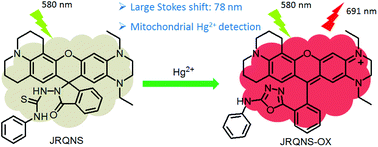A novel near-infrared fluorescent probe with an improved Stokes shift for specific detection of Hg2+ in mitochondria†
Abstract
The mercury ion (Hg2+), one of the most notorious heavy metal ions, not only causes environmental pollution, but also endangers human health. There is evidence that Hg2+ tends to accumulate in the mitochondria and to induce apoptosis. However, mitochondria-targeted near-infrared (NIR) fluorescent probes with large Stokes shifts are still scarcely described for the specific detection of Hg2+. In this work, a novel near-infrared fluorescent probe JRQNS with a large Stokes shift (78 nm) was reported, and applied for sensitive and specific detection of Hg2+ in mitochondria by incorporating an additional amine group with fused rings to rhodamine dyes to enhance the electron donating ability of amine groups. As expected, the probe exhibited high selectivity and sensitivity to Hg2+ with a detection limit as low as 1.5 nM and fast response times (3 min), revealing that JRQNS could be used as a practical probe for quantitative detection of Hg2+ in real-time. Importantly, JRQNS can be used as an efficient organelle-targeting probe for imaging Hg2+ in the mitochondria of living cells, and thus detect Hg2+ in real-time there. The application of the probe for its selective localization in mitochondria along with the nanomolar level of limit of detection to Hg2+ ions provided a potential tool for studying the cytotoxic mechanisms of Hg2+.



 Please wait while we load your content...
Please wait while we load your content...